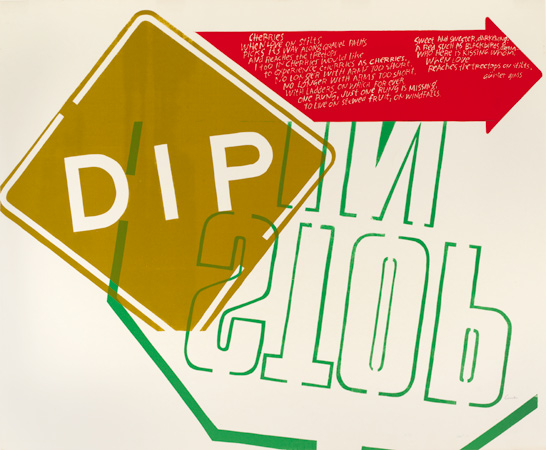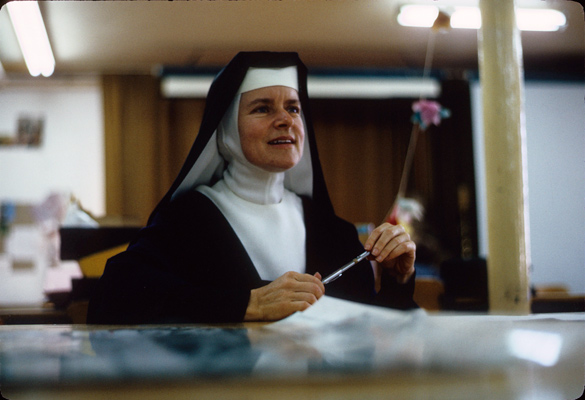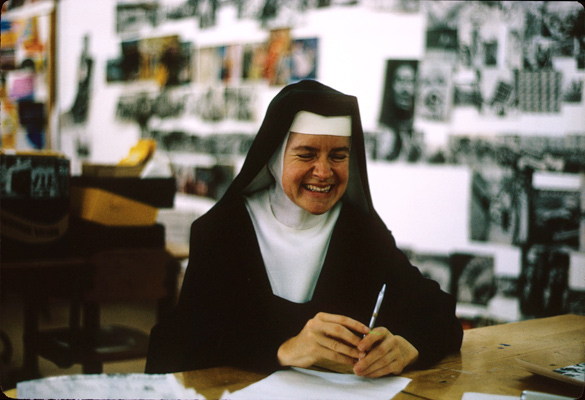We’ve recently told you about Corita Kent’s place in the pop art movement, and about her use of unconventional materials in screenprints, ahead of our special exhibition Corita Kent and the Language of Pop, which opens today. But what was she like as a person? To answer this question, we turned to Mary Anne Karia (née Mikulka), a close friend of Kent’s for over two decades. (Karia also generously shared key insights with curator Susan Dackerman as part of the research and planning for the exhibition.)
Karia was introduced to Kent’s prints through her mother, Elinor Mikulka, who discovered Kent’s work at the Botolph Group Gallery in Boston. Later, in the 1960s, she became a student and assistant of Kent’s at Immaculate Heart College in Los Angeles, where Kent was head of the art department. Karia and her family stayed in touch with Kent until the artist’s death in 1986.
“For me, Corita was like a window to the world,” Karia said in a recent phone interview from her home in New York. “She taught me to see. She read constantly and often recommended books. When I first arrived in New York, I was very low. I was adjusting to the city and there were many challenges in my life. Corita and I would talk every few weeks. After our conversations, I would feel as if someone threw open the windows of my life. She was a very special friend.”
Karia shared with us numerous other recollections about Kent’s one-of-a-kind character.
On Kent as an art teacher:
In our art structure class, she would start out with a film, discussion, and assignment; then she would involve the students. The Eames films were a favorite, visually beautiful and thought-provoking. For one assignment, we had to make 100 drawings with a stick and India ink on 8-by-11 paper of one image found in a magazine. There was no time to critique your work; you just kept going. It would result in some of the most exciting drawings because you would eventually free yourself of all the restrictions you had about creating something, and just do it—and do it well.
On Kent’s love of billboards:
She used to love to drive the freeway. I was a nature freak at the time, and I hated the billboards; they caused me great discomfort. All through [our drives together], she would get so excited. “Oh look at that one! Look at that one!” And after a while, I got to love them, too.
There was one blank billboard that said, “Wait till you see what’s coming.” We had never seen anything like it. I remember her reaction: “Oh, we must find a reason to drive here again so we can see what’s going to be on it next!” Weeks later, we laughed together when we saw it was an advertisement for toilet paper.
On Kent’s outlook on life:
She had a wonderful sense of humor, but she also suffered a lot. Everyone thought of her as this jolly little nun, but she had some real challenges in her life. She also dealt with serious insomnia and other difficulties in the convent. She managed it all. She never missed a class, and maintained her consistently gentle spirit.
I think her positive outlook, the people she loved, and her interests sustained her. Every human being is like that, if they’re doing something they really love.
On Kent’s approach toward others:
She was so fully present, even at big gallery openings, where people were coming at her and surrounding her, asking questions throughout the whole evening—and I knew she was really tired because we had come there together. She addressed every person, and always looked them in the eye. She spoke to each person as if they were the only person in the room.
I think at some point in her life, she decided she was going to look at the positive side of things. Not in a Pollyannaish way, but in a survivalist way. And that was what she did. She addressed every human being as a soul, not just as a person who came to her gallery, and she did it with such dignity.
Corita Kent and the Language of Pop is supported in part by an award from the National Endowment for the Arts and major corporate support from National Grid.




